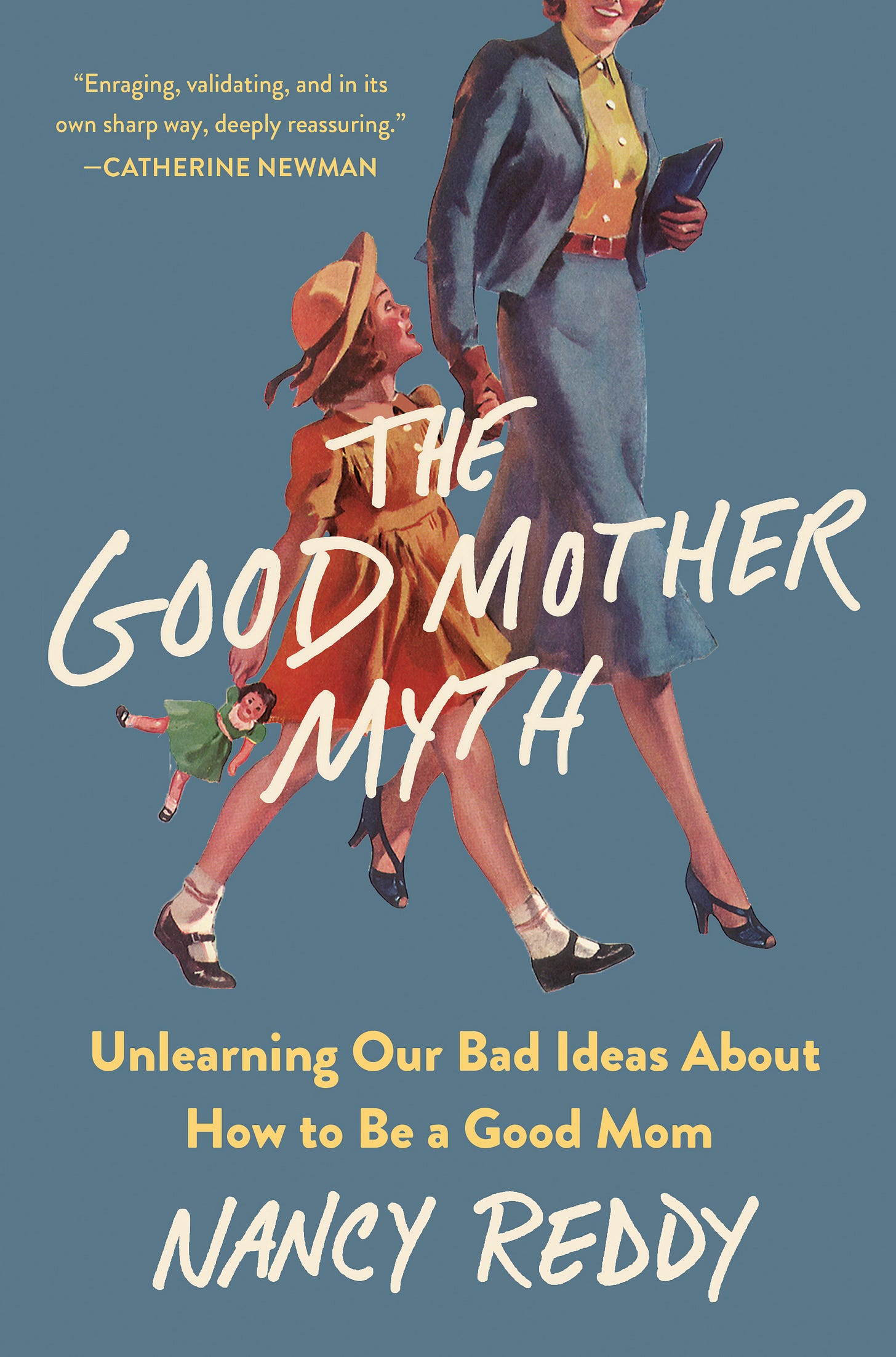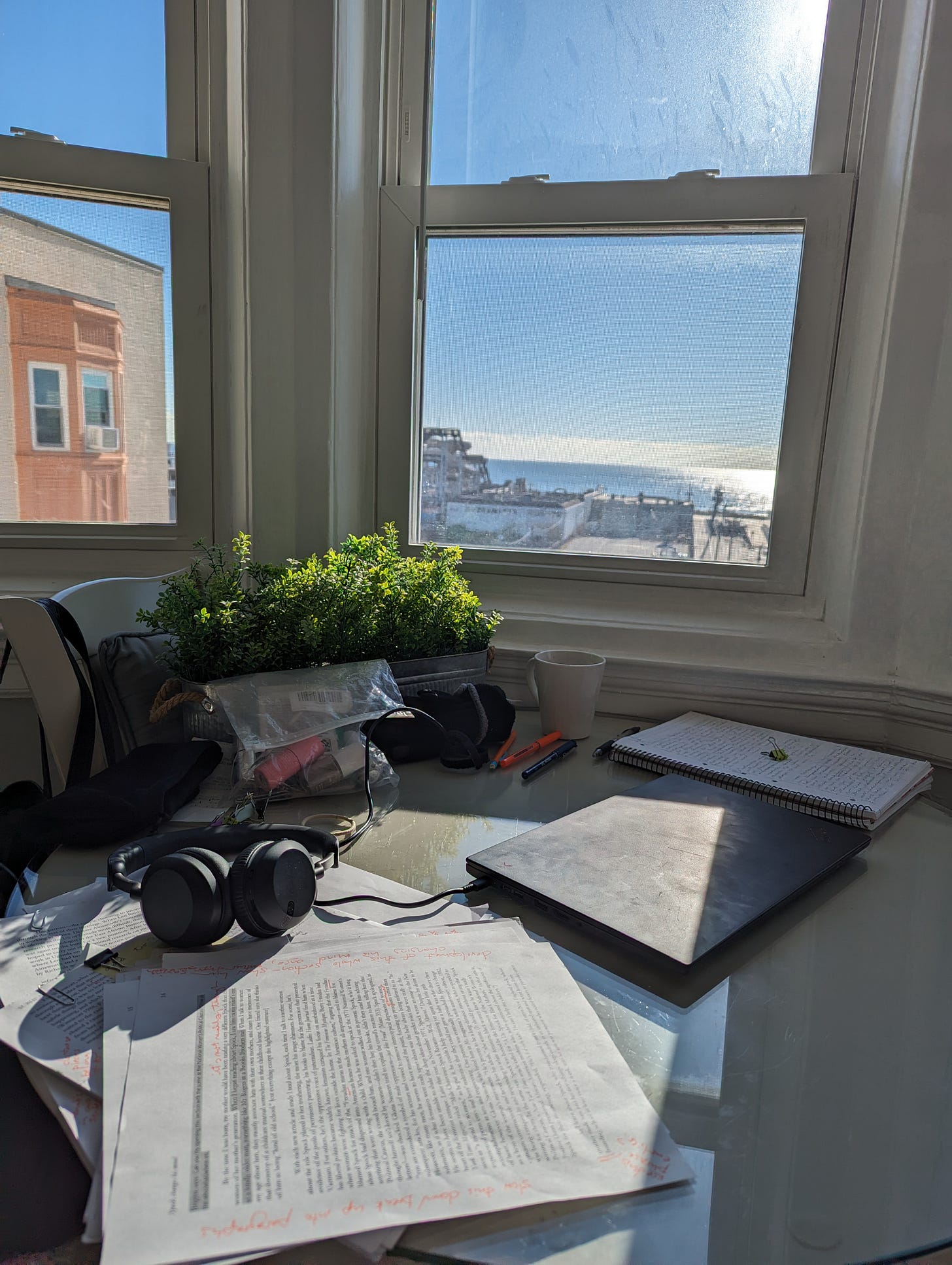Nancy Reddy Grabbed a Stack of Index Cards and a Roll of Painter's Tape
Writing = Making and Solving Problems, Try This at Home!
Hi Friends,
Greetings from Portland, where we’ve driven to spend the holidays with family. Thanks to Bridget for the recommendation of Natasha Pulley’s The Mars House—the audiobook kept all four of us happy on the long drive.1 This time together is extra sweet after the big uncertainties of the summer.2
Writing = Making and Solving Problems
Over time, I’ve come to realize that problems aren’t an impediment to writing. Problems are the substance of writing: we set problems for ourselves and we work them out. In this feature, I ask writers to dig into a specific writing problem and how they resolved it.
I’ve been in conversation with
for a while, mostly at a distance. I’ve followed her newsletter for some time and been a guest here and there as well. We’ve met up at AWP, and I’ve Zoomed in to do a class visit with her students about daily practice and attention. Nancy does so many things with so much thoughtfulness and generosity!Her book The Good Mother Myth publishes January 21st, 2025, and is available for pre-order now! Having, like Nancy, had my first child as a PhD student, I’ve found much to connect with in this book. And as someone working on creative nonfiction book, I find it so useful to hear how Nancy got through the weeds of her ambitious project. I’m thrilled to share our conversation about finding the shape of The Good Mother Myth with you!
What are three key things to know about this book?
The Good Mother Myth is hybrid memoir, or memoir plus, so it tells the story of my early years of motherhood, intertwined with research into the midcentury science behind our present-day bad ideas about how to be a good mom. (Think: Harry Harlow, who did the cloth mother studies with baby monkeys you probably remember from intro psych; John Bowlby and Mary Ainsworth, the founders of attachment theory; and Dr. Spock, whose parenting guide outsold everything but the Bible for much of the second half of the twentieth century.) It’s both deeply personal, full of the cracked nipples and weepy leakiness of the early postpartum, and really rigorously researched. (And in case that all sounds too dark and heavy, it’s also got lots of joy and some snarky humor. An early reader told me recently that she was surprised by how funny it was, which made me really happy!)
One big idea from the book is that so much of what’s really hard about motherhood is a product of culture and economics—the absence of paid leave and affordable childcare, the pressure to be a “good mom” and how that often means feeling like you shouldn’t need help from a partner or a community—but the actual work of mothering, the relationship with another particular, amazing, weird person, can be joyful and transformative. In other words—the institution of motherhood is kind of a scam, but getting to be a mom can be pretty amazing.
The Good Mother Myth is my first book of nonfiction, and I think of it as being in a secret trilogy with my other recent books: the poetry collection Pocket Universe and the anthology The Long Devotion: Poets Writing Motherhood. Some of the same moments and ideas show up in The Good Mother Myth and Pocket Universe, and the work of editing The Long Devotion with my friend and fellow poet Emily Pérez helped me consider so many experiences of mothering beyond my own.
What’s a problem—small or large—that you encountered while making this book?
When we sold The Good Mother Myth, in April 2023, I’d been working on it for a long time. I’d spent nearly a year working with my agent to develop the structure of the book, and I felt clear about the big picture of what should be in each chapter. So once I settled down to draft the new chapters, I tricked myself into thinking that writing it would just be a matter of typing it up. (Spoiler alert: that’s not how writing works!)
The major challenge was scale. I did a little math and realized that, with seven chapters and a target word count of 70,000, each chapter was going to contain as many words as my entire last book of poetry. Because I’d already been working on the project for so long, I had plenty of words—years’ worth of notes and scenes and good ideas, plus all the new things I’d uncovered as I reviewed those research notes. But were they the right words? While it was all fascinating to me, I had enough self-awareness (thank goodness) to realize that a reader might not actually need to know every single weird thing I’d learned about Donald Winnicott’s first marriage (Though ask me in person and I’d love to tell you!) So what I’d thought would be a zippy process of just writing up each of my chapters quickly had me feeling overwhelmed.
My poetry education had given me the skills to refine the micro of a poem or a sentence, and writing a dissertation and shaping collections of poetry had taught me how to think at the macro scale of a book, but I didn’t have the same set of tools for managing the mushy middle-length of a chapter. What I figured out, though, was that I just can't keep 10,000 words in my head at once, so I had to develop new strategies for outlining and thinking about the scale of the chapter and how each chapter relates to the book.
What did you do? How did you move forward?
I pretty quickly realized that:
the writing process that had worked really well for me in poetry, with lots of freewriting until I found the poem, then pain-staking revision to hone in on the poem’s heart wasn’t going to work for prose, and
I needed a way to help myself see the big picture of each chapter with the same clarity I’d had for the book as a whole.
I needed to stop writing—the freewriting that worked for poems was producing way more words than I could handle when I tried it with prose!—and create a big, visual outline of each chapter for myself. I grabbed a stack of index cards and my roll of painter’s tape and jotted down the key scenes, important research findings, and other details, then taped them on the large, empty wall in my home office. The index cards forced a measure of economy, since I couldn’t explain the nuance of a study or wax poetic, and taping them up meant I could easily move things around and see the relationship between the parts. Color coding, with one color index card for memoir and another for research, helped me to think about the balance between the different materials I was using.
My friend Ana offered a question that helped me clarify what ideas, information, and scenes should go into each chapter: what do I want a reader to see, understand, and feel here? That question also helped me to think about how each chapter would relate to the ones before and after it: what is the emotional arc from 2 to 3, for example? What has the reader learned from 4 that matters for 5?
What drafting the chapters of The Good Mother Myth taught me is that if I’m working on something longer than a poem, I have a really hard time moving forward without an image of the whole. And sometimes that image is just a post-it with three key ideas jotted on it, but for something meaty and complex like a book chapter, it’s worth spending the time developing the structure for the whole before diving into the details. I just can’t work well on a project I can’t see.
None of that, of course, saves you the hard work of editing later. After I’d submitted a draft of the entire manuscript to my editor, she had some major structural edits: developing an introduction, and splitting what had been chapter 1 across 1 and 2! So I went back to what I know works: making it tactile and making it visual. I printed everything out and spent a long weekend at the world’s tiniest AirBnB (though one with a view of the ocean!) cutting those drafts apart and putting it all back together.
is the author of The Good Mother Myth, forthcoming with St. Martin’s Press in January 2025. Her previous books include the poetry collections Pocket Universe and Double Jinx, a winner of the National Poetry Series. With Emily Pérez, she’s co-editor of The Long Devotion: Poets Writing Motherhood. Her essays have appeared in Slate, Poets & Writers, Romper, The Millions, and elsewhere. The recipient of grants from the New Jersey State Council on the Arts and the Sustainable Arts Foundation and a Walter E. Dakin Fellowship from the Sewanee Writers’ Conference, she teaches writing at Stockton University. She writes the newsletter Write More, Be Less Careful.Try This at Home
For writers grappling with similar challenges, Nancy suggests accepting some chaos as inevitable: “It’s really helpful to just accept that a little bit of mayhem and uncertainty and frustration is part of the process, no matter how long you’ve been writing or how long you’ve been working on a particular project. It doesn’t mean that you’re doing anything wrong. (It probably means you’re working really hard and doing something new! When I interviewed the writer Keri Bertino for my newsletter, we were talking about these moments of crisis with a big project, and she said very often those moments come right before we're about to level up on something. I think that’s really true.)”
She also recommends finding a way to visualize the major moves of something big: “If you’re feeling stuck with a big project, it might very well be because you don’t have a handle on the big picture. The best way I know to unstick that kind of problem is to find a way to make the project tactile and visual, whether that’s printing it out and moving the pieces around or using index cards or bulletin board paper to make a wall-sized outline. Once you can see your tangle, you can often start to get yourself unstuck.”
An Invitation from Nancy
Nancy invites you to join a 2025 Vision Mood Board Party via Zoom on January 5th, 2025 at 3 pm Eastern. Read all about it here!
More Writers Talking about Hybrid Nonfiction
Holidays are a time for magic, often achieved through the work of moms. In the spirit of The Good Mother Myth, if you’re around a mom, take something off her plate. If you are a mom, share the work! Or just put something down. It’ll be ok.
Yours with plans for salted chocolate pudding,
Bronwen
PS: If you liked this post, please hit the heart to let me know! You can also support this newsletter by subscribing, sharing, or commenting.
It’s about a marriage of convenience on a Mars! If you’re looking for a thought-provoking and funny and super readable novel, don’t hesitate.
For friends following my dad’s health, he’s holding steady at the moment and scheduled for a stem cell transplant in early January.












thanks for sharing this, Bronwen!
Those notecards!! 💕